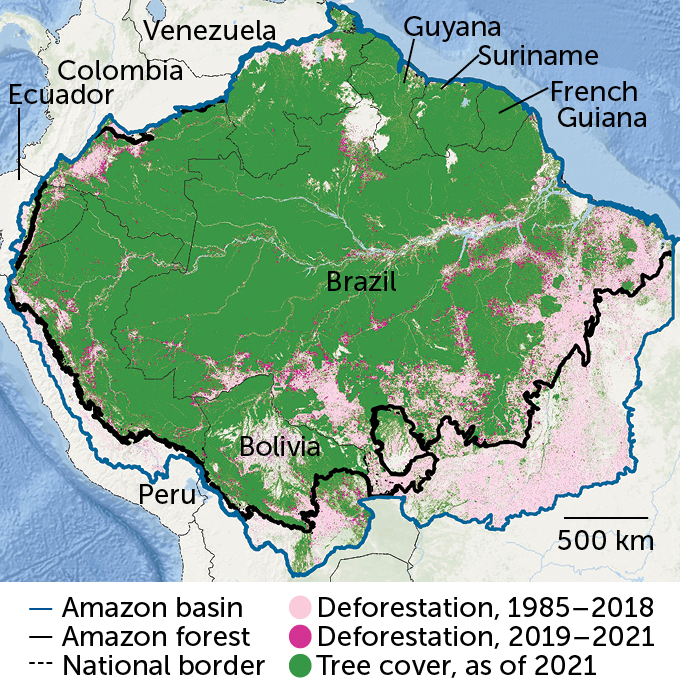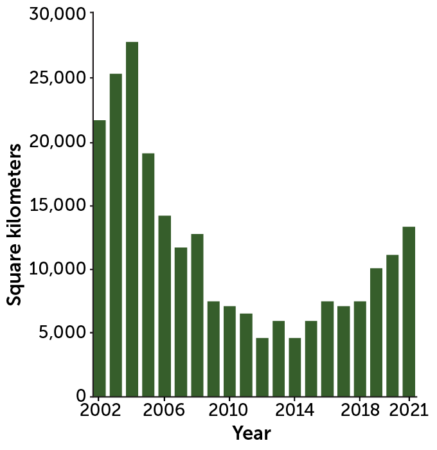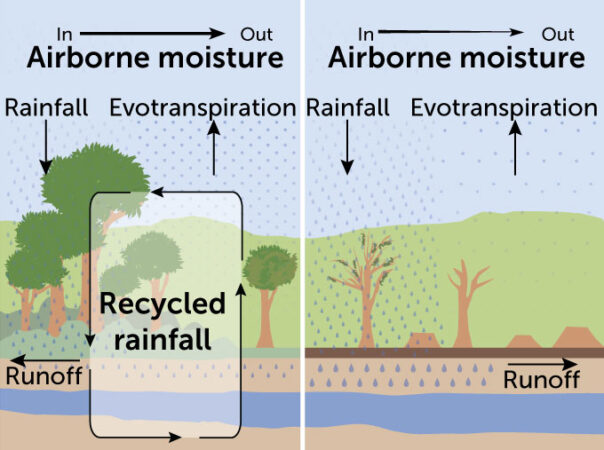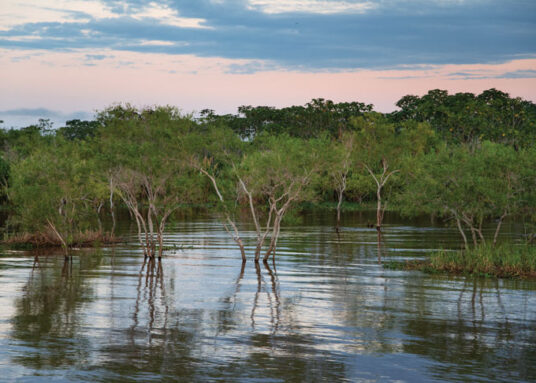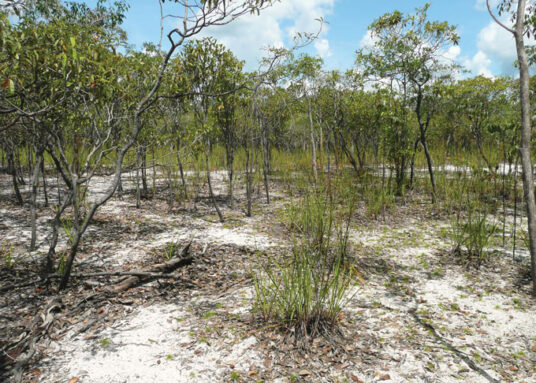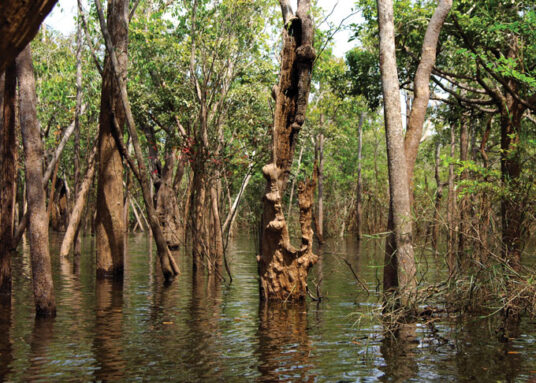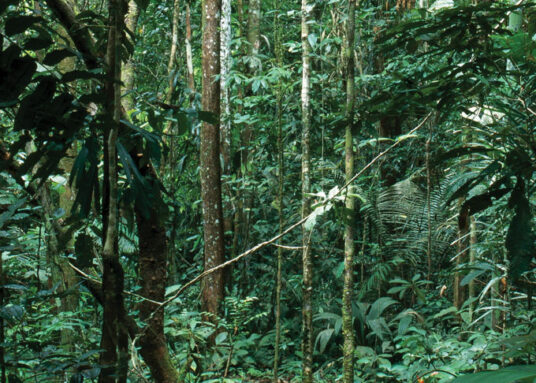This post was originally published on this site
The shore of a sea of nearly 400 billion trees winds through the central Brazilian state of Mato Grosso. Here, the Amazon rainforest rubs up against the Cerrado, the world’s largest savanna.
The two are distinct worlds — one a wet and verdant jungle, the other relatively dry and blanketed in wild grasses, shrubs and small trees. But no clear line demarcates the Amazon and the Cerrado. Instead, there’s a messy transition zone, a continuum of vegetation that grows taller toward the rainforest. Over thousands of years, the boundary ebbs and flows, driven by natural fluctuations in climate.
“But in this formula is a new element,” says ecologist Beatriz Marimon of Mato Grosso State University in Nova Xavantina. Humans, with their ambitions to domesticate the land, she says.
About half a century ago, throngs of people started streaming into the region along new highways, clearing forest for farmland and cattle ranches, she says. Fifty years is a blink in the life span of a forest nearly as old as the dinosaurs, but it’s plenty of time for humans to remodel a landscape.
In 2007, earth system scientist Carlos Nobre, now at the University of São Paulo, and his colleagues suggested that much of the Amazon could transform into a savanna if deforestation exceeded 40 percent of the forest’s original area, which was mostly whole before the 1970s.
About a decade later, after accounting for interactions between climate change, deforestation and fire, Nobre and a colleague offered a more dire warning. If just 20 to 25 percent of the Amazon was deforested and global warming reached about 2.4 degrees Celsius above pre-industrial levels, the ecosystem could collapse and much of the forest could transform into savanna and shrubland, they found. Today, humans have already deforested about 17 percent of the overall Amazon, and damaged much more, estimates suggest.
That the Amazon may transform into something else after reaching a point at which it cannot cope with exacerbating conditions — a “tipping point” — has raised alarms. Such a shift would imperil the forest’s storied biodiversity and the livelihoods of millions of people. It would also release immense volumes of carbon dioxide and alter the global circulation of heat, vastly complicating efforts to slow climate change (SN Online: 1/10/20).
The Amazon is in grave trouble, scientists agree. Human activities and climate change are exacerbating the dry season; in some areas, it lasts four to five weeks longer than decades ago. Fires have also become more fierce. All of that is stressing the forest out.
But much like the physical transition separating the Amazon from the Cerrado, the forest’s limit is probably not defined by a single, clear tipping point, many scientists now say. The Amazon is no monolith. Different parts may react to threats in different ways, Marimon says.
A multitude of poorly understood factors affect the forest’s fate: The myriad forms of human actions. Climate change. The diverse capabilities and adaptations of plants. The ambit of underground water.
Ongoing research is clarifying if, when and where conditions may push the forest beyond its limits, and could help inform efforts to save the forest from potential widespread dieback. These are urgent tasks, as it’s not yet clear how much time may remain to save the forest, or if it’s already at the brink of some irreversible shift, says Matt Finer, director of the Monitoring of the Andean Amazon Project, or MAAP, based in Washington, D.C. In either case, he says, “we’re kind of probably the last ones with the option to ponder that.”
Felling the Amazon
Ecologically speaking, the Amazon is without equal. It accounts for more than half of Earth’s remaining tropical forests, through which roughly 17 percent of the world’s river water flows. It also houses about 1 in 4 of the world’s land-dwelling species. That unfathomable bonanza includes its flowers: More types of flowers bloom in the Amazon than there are stars visible to the naked eye in the night sky. What’s more, each year the rainforest absorbs about 5 percent of the world’s annual CO2 emissions from fossil fuel burning and land use changes, with its carbon reserves weighing as much as 230 million blue whales (SN: 12/18/21 & 1/1/22, p. 6).
Much of this vitality is sustained by the trade winds, which blow east to west across the forest from the Atlantic Ocean. The winds carry sea-born moisture into the eastern parts of the forest, where it precipitates. Once fallen, some of this water evaporates back into the air. Much of it soaks into the soil. It’s absorbed by roots, courses up through plant stems and tree trunks, and is then transpired through leaves back to the sky (SN: 4/23/22, p. 9). A single tree in the Amazon can pump 500 liters of water into the atmosphere each day.
Winds whisk the moisture hundreds of kilometers deeper into the forest, where it rains on more trees. A single molecule of water may repeat this cycle more than five times before exiting the forest basin. The Amazon waters itself.
But this arrangement has vulnerabilities. If enough of the forest’s eastern expanses are cut down, moisture may run off and out of the basin rather than sail into deeper sections of the forest that need it, Finer says. “That deforestation cuts off the whole system.”
Already, about 30 percent of the Amazon’s eastern third has been cleared, Finer and colleagues reported in a 2022 MAAP report. Deforestation averaged across the whole forest may not yet have crossed that 20 to 25 percent threshold, but “in that eastern third, it’s way worse,” Finer says. If that destructive trend continues in the east, it could decapitate the Amazon’s skyborne streams of moisture, he says. Finer doesn’t think the forest has yet crossed a tipping point, but, like other scientists, stresses it could be hard to know for years.
Even if this rain recycling goes bust, the forest’s western region — about a third of its expanse — could still hold out. This area is backed by the towering Andes, which wring westbound winds of water and ensure that heavy rain falls upon nearby forests. The area’s lush vegetation shouldn’t suffer too terribly from distant deforestation, Nobre says.
Deforestation doesn’t just harm the tracts where trees are felled. The warming and drying that follow in deforestation’s wake may spill over into the edges of intact forests nearby, affecting which plant and animal species persist there. That’s one of the many ways forests become degraded, a condition that’s often less obvious than outright clear-cutting.
Nonetheless, it’s pervasive. About 38 percent of the remaining Amazon rainforest has been degraded, researchers reported in January in Science. That’s an area equivalent to nearly a third of Brazil, or more than three times the size of Texas.
Degradation can take many forms, with repercussions that vary depending on the damage’s nature, intensity and scope. Fires can raze parts of the rainforest. If the burned land is left alone, Amazon plants typically return on their own, bursting forth from seeds and roots in the soil. But severe fires can destroy these buried remnants too, denying some species the chance to return. As such, the forests that grow back often lack the diversity of their predecessors. Where humans have repeatedly burned the land in the past, the forest may recover more slowly and be dominated by just a few fire-resistant species even after two decades.
Meanwhile, selective logging can open a forest’s closed canopy, ushering in sunlight to heat and dry the understory, killing some plants, exacerbating fires and pushing out animals.
Where degradation reduces vegetation, it shrivels transpiration. For each leaf lost, the forest’s moisture loses one little gate back into the sky. During a typical dry season, severely degraded forests may release 34 percent less water back to the sky. That loss directly sabotages the forest’s rain recycling, imperiling trees that depend upon it.
Because degradation can unfold in so many ways, computer simulations that project changes in the Amazon’s vegetation cannot say exactly how it may contribute to a tipping point.
“It’s logical to think that such degradation helps push the system towards the tipping point, if it really exists,” says earth system scientist David Lapola of the University of Campinas in Brazil. But “we can’t today say this percentage of degradation will make the system tip to another stable state.”
A drier future
The Amazon isn’t just dealing with deforestation and degradation, of course. Over the last 50 years, the average annual temperature across the forest has climbed at least 0.6 degrees C. And exceptionally severe droughts have struck the forest three times in the last two decades. Some climate models suggest that by 2060, such extreme drought conditions could occur as often as 9 in every 10 years.
Recent climate simulations suggest that if such drought years became the new “climate normal,” patches of the rainforest may transition to a different state — whether that be savanna or a more open or dry forest — at different times, not all at once.
Some of these localized shifts could trigger a domino effect, causing nearby areas to also shift, researchers reported last year in the Proceedings of the National Academy of Sciences. The Amazon’s southeastern forest appears to be highly vulnerable to local diebacks, while areas downwind to the west seem to be liable to the domino effect.
Projections from the Coupled Model Intercomparison Project, which coordinates and standardizes climate projections, also point to localized Amazon diebacks. For a 2022 study, researchers examined projections from the sixth phase of the project, or CMIP6, analyzing models that simulate the response of vegetation to climate change. Five of the seven analyzed CMIP6 models indicate that the risk of sudden, local diebacks will climb as the world reaches and surpasses 1.5 degrees C of global warming above preindustrial levels.
But no two projections completely agree. Even when the same amount of climate change is assumed, CMIP6 models produce different pathways, with diebacks occurring at different points. One model predicts diebacks could begin around 1.3 degrees C of warming, another at about 1.7 degrees C.
The lack of agreement comes in part because these models — and others used to predict the Amazon’s fate — make different assumptions about the complex nature of the world’s greatest rainforest.
Taking a closer look at that complexity may reveal ways in which the forest is more — or less — resilient than we think.
Hidden nuance in the trees
Often, talk of “the Amazon” evokes visions of dense, dripping vines and trees. But the forest is actually a messy medley of ecosystems. There are the vivacious várzeas — floodplains occupied by dense forests, grasslands and swamps that, for months of the year, become inundated under nutrient-rich water, which sustain an abundance of fauna and flora.
The várzea’s uliginous counterpart, the igapós, consists of swamp forests that also flood seasonally, though with nutrient-poor waters as dark as maté, steeped in tannins leached from decaying plants. Igapó trees grow slowly, but they grow dense and excel at sequestering carbon.
Then there are the diverse terra firme, the tall, thick, closed canopy jungles that cover the uplands, above the flood line. Even naturally occurring white-sand savannas can be found within the Amazon’s borders. As for trees, roughly 230 species are thought to dominate the forest, while around 16,000 species have been cataloged in the basin.
Nonetheless, research projects often simulate the Amazon’s vegetation as relatively homogenous, says earth system scientist Marina Hirota of the Federal University of Santa Catarina in Florianópolis, Brazil. They cast every tree as a broadleaf evergreen tree, the forest as a monoculture. These simplified simulations, called “big leaf” models, prevail because researchers lack data, Hirota says, but the models don’t do the forest justice.
Over millions of years, the forest’s myriad plant communities have evolved differently to cope with local rainfall patterns. Research suggests that projections may not fully capture how the lush diversity of plant traits affects the Amazon’s ability to endure and adapt to stress like climate change–induced droughts.
Take for instance, embolism resistance. When soils dry, plants may inadvertently suck bubbles of air into their vascular systems, causing a sometimes-lethal blockage called an embolism. Tree species inhabiting the more drought-prone central eastern Amazon tend to grow slower but be more resistant to embolism and vascular collapse than species in the forest’s west. Hirota, Marimon and their colleagues reported this finding in April in Nature after studying 129 tree species from 11 plots across the Amazon. The work suggests rainfall patterns have shaped plant communities’ capacities to cope with drought.
Then, there’s what lies underground — the groundwater — which is poorly captured by many simulations. Most investigations into the forest’s response to drought have focused on upland areas overlying deep water tables, which roots struggle to access. But about half of the Amazon may stand atop a relatively shallow water table. That accessible groundwater could sustain plants through droughts in ways that models don’t account for, says ecologist Flávia Costa of Brazil’s National Institute of Amazonian Research in Manaus.
Such areas could serve as drought refugia, Costa says: “Places that do not suffer.” But if drought gets too severe and groundwater recedes beyond the reach of roots, refuges could become ruinous. “Those places may be the ones that suffer the most because the plants are not adapted” to dry conditions, she says.
Hirota, Marimon and others are still studying how Amazonian plants are coping with drought to amass more information about what Hirota calls plants’ “life strategies.” The goal is to use the data to improve existing vegetation models and simulate more accurately the diverse responses to climate change and land use changes.
This research, and other investigations into the many capabilities and adaptations of the Amazon’s plants, will be necessary to better inform projections of the Amazon’s fate, Hirota says. The same, Costa says, goes for the influence of groundwater.
A third source of uncertainty in figuring out the Amazon’s fate wafts invisibly through the air. Researchers had previously suggested that an atmosphere richer in CO2 might boost the forest’s growth, potentially offsetting some of the tolls of climate change. Some experts had even proposed that this “atmospheric CO2 fertilization” could preclude a massive forest dieback.
But CO2 and sunlight aren’t all that’s needed for growth. Plants also consume nutrients from soils, and Amazonian soils are notoriously lacking, especially in phosphorus (SN: 1/28/23, p. 10; SN: 4/10/21, p. 7). Using computer simulations for a 2019 study, Lapola and colleagues found that a dearth of phosphorus would probably reduce the projected growth gains associated with more abundant CO2 by about 50 percent over 15 years. The team’s conclusion: Previous projections may have overestimated the benefits of extra carbon dioxide.
No large-scale experiments have yet tested the effects of CO2 fertilization on the Amazon. But Lapola and colleagues have almost finished constructing steel towers that will spray carbon dioxide over mature groves in the Amazon, to see how the trees respond. It may still take years to acquire meaningful results.
What comes next?
At this point, scientists don’t have enough information to say when, or if, the Amazon will cross some threshold beyond which it becomes unrecognizable, Lapola says. Today’s computer models are trying to open doors into the future, to peer beyond thresholds and see what’s ahead for the Amazon. But with the data available today, “we’re looking into a room from the hole of the lock.”
That a web of local diebacks could unravel across the forest is worrisome, but that fragmented fate may carry more hope than a single catastrophic switch, Hirota says. For one, it could help dissuade people from writing the forest off as a lost cause after crossing some predicted limit.
Resignation is a serious concern, Nobre says. “If we take for granted that the tipping point has already been exceeded, then people say forget it.”
Nobre aims to restore some of the forest’s most deforested areas, to tilt the Amazon away from that momentous tip, or to at least rein in the lengthening of the dry season. He and others have called for extensive reforesting along what they call arcs of restoration. “One arc over the southern Amazon, another one along the Andes,” he says. Such work hasn’t yet begun.
Even if it does, restoration alone cannot succeed if deforestation and degradation continue. It takes far less time to timber a tree than to grow one.
Not all human activity has harmed the forest. People from Indigenous groups have acted as stewards of the forest’s biodiversity for millennia. Plants that they domesticated long ago, such as Brazil nut trees and umari trees, are still abundant in some areas near ancient settlements. Today, Indigenous territories as well as protected areas make up more than half of the forest in the Brazilian Amazon. Since 2000, only 5 percent of forest loss has occurred on these grounds. Working with the people living in these areas to stave off further deforestation and degradation will be key, researchers say.
But the forest’s fate will depend on more than restoration and conservation efforts in South America. Greenhouse gases emitted by nations around the world are driving many of the challenges the Amazon faces.
And Marimon implores people to stop buying Amazonian beef and other products that fuel the engine of deforestation. Around 75 percent of the land deforested in the Amazon is used as pastures for grazing cattle, and Brazil is now the world’s largest exporter of beef.
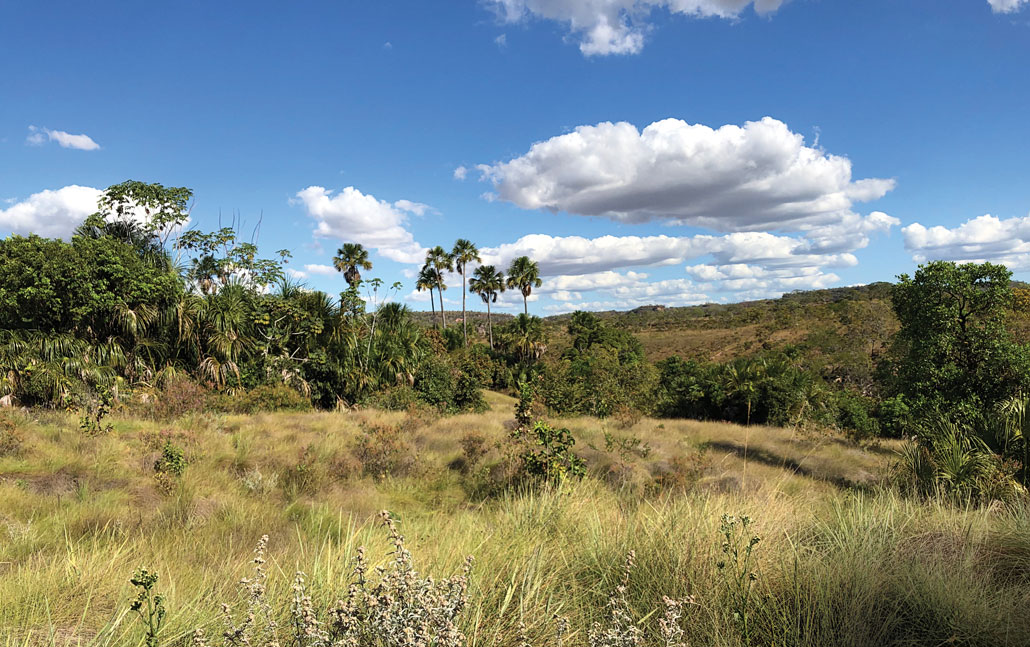
Taking real steps to change behavior is in the best interest of all who call this planet home. Beyond the Amazon’s irreplaceable biodiversity, beyond its colossal carbon stores, there are wind and ocean currents that connect the forest to regions across the globe (SN: 3/11/23, p. 9). Amazonian temperature anomalies have been linked to anomalies in the Tibetan Plateau, where glaciers that supply around 2 billion people with drinking water are shrinking, and to the West Antarctic Ice Sheet.
Back in Mato Grosso, Marimon suspects that the changes she’s witnessed there could eventually unfold across much of the Amazon. Year after year, more trees disappear and the air is getting hotter. Insects that once buzzed about in throngs have vanished. And in some places, the piercing shrieks of the capitão da mata — an iconic, vociferous bird — have vanished. Shrieks that warned to all who heard them: Danger is afoot.
